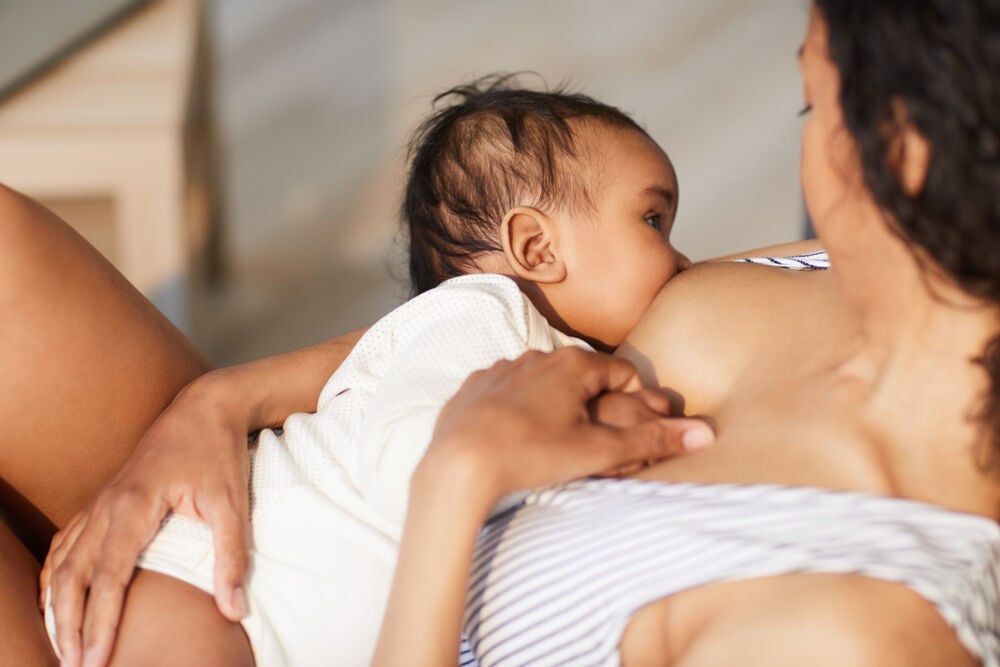Mastitis is an inflammation of breast tissue, occasionally occurring with an infection. It commonly develops in women who are breastfeeding. As mastitis can be very painful and lead to additional complications, it’s essential for breastfeeding mothers to know how to prevent mastitis.
-
Tracking cycle
-
Getting pregnant
-
Pregnancy
-
Help Center
-
Flo for Partners
-
Anonymous Mode
-
Flo app reviews
-
Flo Premium New
-
Secret Chats New
-
Symptom Checker New
-
Your cycle
-
Health 360°
-
Getting pregnant
-
Pregnancy
-
Being a mom
-
LGBTQ+
-
Quizzes
-
Ovulation calculator
-
hCG calculator
-
Pregnancy test calculator
-
Menstrual cycle calculator
-
Period calculator
-
Implantation calculator
-
Pregnancy weeks to months calculator
-
Pregnancy due date calculator
-
IVF and FET due date calculator
-
Due date calculator by ultrasound
-
Medical Affairs
-
Science & Research
-
Pass It On Project New
-
Privacy Portal
-
Press Center
-
Flo Accuracy
-
Careers
-
Contact Us
How to Prevent Mastitis: The Ultimate Guide


Every piece of content at Flo Health adheres to the highest editorial standards for language, style, and medical accuracy. To learn what we do to deliver the best health and lifestyle insights to you, check out our content review principles.
Overview
The World Health Organization defines mastitis as a condition where the breast is inflamed, with or without infection. The condition is also known as lactational mastitis or puerperal mastitis.
Lactational mastitis is when a breastfeeding woman’s breast becomes swollen, red, and painful. It’s most common during the first three months of breastfeeding. The condition starts with poor milk drainage. The lack of proper drainage could be due to nipple trauma, which results in the compression and swelling of milk ducts. If symptoms of puerperal mastitis last more than 24 hours, the condition develops into infective lactational mastitis. This is because breast milk contains bacteria that can cause an infection.
Mastitis occurs all over the world, occurring in a reported 2–10 percent of breastfeeding women. If someone has had lactational mastitis before, they are at a higher risk of having it again.
Between 74–95 percent of cases are reported to occur within the first 12 weeks after delivery. However, breastfeeding mothers can develop this condition at any stage of lactation, even two years after giving birth.
Often, signs of mastitis will appear quite suddenly. Symptoms include:
- Warm breasts
- Tender or swollen breasts
- Breast lumps
- Thickening of breast tissue
- A burning sensation or pain while breastfeeding
- Red skin
- Fever of 101 degrees Fahrenheit or higher
Women who are breastfeeding can take specific actions that may help to prevent mastitis:
- Avoid tight clothing and bras.
- Encourage frequent feedings.
- Allow the baby to complete their feedings.
- Help the baby latch onto the nipple properly.
What causes mastitis?
The leading cause of lactational mastitis is milk trapped in the breast (milk stasis). Other possible causes include the following:
- A blocked milk duct can cause milk to back up. The bacteria that are naturally present in breast milk can then cause an infection. Blocked milk ducts commonly occur when a breast doesn’t get emptied during feedings.
- Bacteria from your baby’s mouth or your skin can enter into the milk ducts through a crack in your nipple or a milk duct opening.
Mastitis usually occurs along with other breastfeeding issues that revolve around poor milk drainage or prolonged engorgement. Examples include:
- Partial blockage of the milk duct, which results in stagnant milk
- Pressure on the breast from seat belts or tight bras
- Infrequent or inconsistent feedings
- Overabundance of milk
- Nipple cracking
- Rapid weaning
- Maternal stress and fatigue
- Illness in the baby or the mother
- Maternal malnutrition
Risk factors for developing mastitis
While anyone who’s lactating can develop lactational mastitis, certain factors put some individuals at a higher risk:
- Women who have previously had mastitis
- Women with cracked nipples
- Wearing a tight bra, carrying a heavy bag, or wearing a tight seat belt
- Improper nursing methods
- Fatigue and stress
- Deficient nutrition
- Smoking
Take a quiz
Find out what you can do with our Health Assistant
How to prevent mastitis
Mastitis is a highly preventable condition. Mothers can try to manage their breastfeeding techniques to ensure they’re doing all they can to prevent mastitis. Understanding what causes mastitis and recognizing early warning signs such as nipple soreness, blocked ducts, and engorgement can help you respond quickly.
Tips for breastfeeding management

For proper mastitis prevention, it’s helpful to have a thorough understanding of breastfeeding management. Proper breastfeeding management will keep the breasts healthy and will make sure the baby is being fed. Here are some helpful tips:
- Start to breastfeed within an hour of delivery.
- Ensure the baby is attached correctly to the breast.
- Don’t restrict the frequency or duration of feedings. Let the baby finish one breast before moving on to the other.
- Exclusively breastfeed for at least four months or, if possible, six. Avoid pacifiers or supplementary foods.
Avoiding mastitis also starts by understanding that many factors can affect the ability to breastfeed and the amount the baby feeds. Some factors may also increase the risk of mastitis:
- Giving the baby other food sources
- Using a pacifier
- Moving to another breast before the baby has finished the first
- Stress
- Missing feedings, including when the baby starts to sleep through the night
- Trauma or injury to the breast
These situations should be avoided as much as possible. However, if they do occur, you can take preventive steps to ensure they don’t lead to lactational mastitis.
Important routines to follow
Incorporating a few easy habits into an everyday routine can help reduce the risk of mastitis. Many of these routines are already practiced in caregiving settings, such as maternity hospitals.
- Babies should stay in the same bed or the same room as their mother.
- Whenever the infant shows signs of hunger, such as looking for the breast or opening their mouth, the mother should attempt breastfeeding.
- In a hospital setting, mothers should receive support with the first feeding and as many after as needed.
Handling breast engorgement
Some new mothers will experience engorged breasts their first week after labor. Removing all the milk will help the breasts neutralize again. When this occurs, here are a few steps to take:
- Ask for help improving the baby’s feeding.
- Breastfeed as much and as long as possible with no restrictions.
- If the feedings aren’t relieving the breast fullness or the nipple is too flat for the baby to attach, then you can try expressing breast milk. Only express enough milk to relieve discomfort.
Breast engorgement should resolve itself within a day or two; otherwise, see a doctor.
Prompt responses to milk stasis
Knowing how to react to early warning signs of mastitis is essential. First, check your breasts for lumps, hotness, redness, and pain. If you’re experiencing these symptoms, along with fever and headaches, here are some steps you can take:
- Get some rest in bed.
- Breastfeed from the affected breast as much as possible.
- Have a warm bath or shower.
- Put a warm compress on the affected breast.
- While the baby is feeding, gently massage any lumps to help the milk flow to these areas.
- If symptoms last more than a day, talk to your doctor.
Other breastfeeding difficulties
If you are having breastfeeding difficulties, it’s a good idea to get skilled help before the problem leads to lactational mastitis. You can get support from midwives or facility-based health workers who have training in breastfeeding management. Here are some of the things these professionals can help with:
- Nipple fissures, pain, or compression
- Breast discomfort after feeding
- A baby who doesn’t feed often
- Uncertainty about milk supply
- Early introduction of other types of food
- Pacifier use
Reducing the risk of infection
Here are some techniques that reduce the risk of infection:
- Frequent handwashing by the mother, caretakers, and medical staff. Research shows that proper hand disinfection in hospitals reduced the incidence of mastitis from 2.8 percent to 0.66 percent.
- Early skin-to-skin contact and rooming with the mother can reduce hospital infections.
- Some mothers use breast massage lotions and sprays to help reduce the risk of infection, but there is no conclusive scientific research about these products.
People who have had mastitis before are at a higher risk of experiencing it again. Some research suggests that it can be helpful to administer a Lactobacillus probiotic during the late stages of pregnancy. One study of 108 pregnant women showed lower incidences of mastitis when participants took the probiotic (25 percent) versus those who took a placebo (57 percent).
Where and when to seek help for mastitis
If you think you have mastitis, it is highly recommended to see a doctor in the following scenarios:
- You don’t see an improvement within 24 hours despite continuing to breastfeed.
- You have mastitis, but you’re not breastfeeding.
- Your symptoms haven’t improved 48 hours after starting antibiotics.
If you’re having any kind of breastfeeding issues, it’s crucial to ask for professional help as soon as possible.
Conclusion
When it occurs, mastitis typically sets in during the first three months after delivery. Mastitis symptoms can range from mild (inflammation) to severe (fever and abscess). The recovery process from mastitis can take time and be uncomfortable. After receiving a diagnosis, you may need to stay in bed for a day. Learning how to avoid mastitis can help you avoid complications and discomfort.


Hey, I'm Anique
I started using Flo app to track my period and ovulation because we wanted to have a baby.


The Flo app helped me learn about my body and spot ovulation signs during our conception journey.


I vividly
remember the day
that we switched
Flo into
Pregnancy Mode — it was
such a special
moment.
Real stories, real results
Learn how the Flo app became an amazing cheerleader for us on our conception journey.




